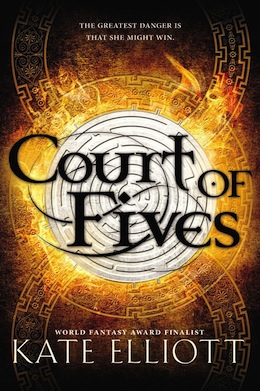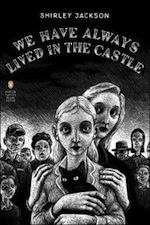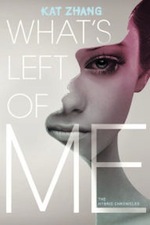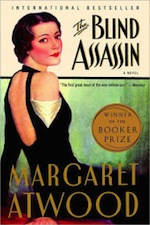I’m one of three sisters, and the older I get, the more I realize what a gift sisterhood has been for me. So naturally, the focus of my first novel, City of Savages, was the relationship between dual-protagonist sisters. With my second, A Criminal Magic (which releases today!), I set out to write a very different story, but after a couple rounds of revisions, I found myself subconsciously working a sister relationship into that one too.
As a writer, I find sister relationships fascinating—sisters can go from joking in their own shorthand to undercutting each other in a matter of minutes, can be each other’s greatest champions and biggest hurdles in the same conversation. And as a reader, there’s nothing better than reading something about sisterhood that hits me with almost chilling familiarity, and whispering as I turn the page, “Wow, this is us.”
Here are five speculative fiction novels that feature unforgettable sisters:
Court of Fives by Kate Elliott
 Kate Elliott’s young adult series has been pitched as Game of Thrones meets Little Women, and the first book absolutely delivers on that irresistible pitch. Yes, this is most certainly an epic fantasy—our female protagonist, Jessamy, lives in a world divided by class, a kingdom where worthy contenders compete in a series of trials called the Fives. But while the world-building is extraordinary, it’s the Little Women aspect of this series that most captivated me. Jessamy and her sisters are all unique, three-dimensional and compelling, and the relationships between them are rich, complex and real.
Kate Elliott’s young adult series has been pitched as Game of Thrones meets Little Women, and the first book absolutely delivers on that irresistible pitch. Yes, this is most certainly an epic fantasy—our female protagonist, Jessamy, lives in a world divided by class, a kingdom where worthy contenders compete in a series of trials called the Fives. But while the world-building is extraordinary, it’s the Little Women aspect of this series that most captivated me. Jessamy and her sisters are all unique, three-dimensional and compelling, and the relationships between them are rich, complex and real.
We Have Always Lived in the Castle by Shirley Jackson
 This twisted, terrific novel tells the story of peculiar Merricat Blackwood and her older, agoraphobic sister, Constance, who live in isolation with their uncle at Blackwood House. When an opportunistic cousin comes calling in search of the family fortune, the sisters’ lives are irreparably disrupted—Constance becomes enamored with a life outside Blackwood House’s walls, but Merricat retaliates with her own unusual brand of “magic.” Psychological suspense and the promise of revealed family secrets keep the pages turning, but for me, the dark beating heart of this story was the fierce, singular bond between Merricat and Constance.
This twisted, terrific novel tells the story of peculiar Merricat Blackwood and her older, agoraphobic sister, Constance, who live in isolation with their uncle at Blackwood House. When an opportunistic cousin comes calling in search of the family fortune, the sisters’ lives are irreparably disrupted—Constance becomes enamored with a life outside Blackwood House’s walls, but Merricat retaliates with her own unusual brand of “magic.” Psychological suspense and the promise of revealed family secrets keep the pages turning, but for me, the dark beating heart of this story was the fierce, singular bond between Merricat and Constance.
What’s Left of Me by Kat Zhang
 Zhang’s premise rests on a unique, claustrophobic definition of sisters: two souls that live together in one body. In this novel’s world, each person is born with two souls, but it’s normal for the body’s dominant soul to “settle” during early childhood, and for the other to fade away. But when the story opens, teen sisters Addie and Eva are still sharing the same body, as well as the dangerous secret that secondary-soul Eva still exists (though she’s unable to move their body or speak, except internally to Addie). What follows is a tense dystopic thriller, but the most standout moments in this debut for me were the very real and heartbreaking exchanges between these sisters. Addie has everything, while Eva only has Addie—and yet I felt for both sisters as they each struggled with identity, loyalty, and sacrifice.
Zhang’s premise rests on a unique, claustrophobic definition of sisters: two souls that live together in one body. In this novel’s world, each person is born with two souls, but it’s normal for the body’s dominant soul to “settle” during early childhood, and for the other to fade away. But when the story opens, teen sisters Addie and Eva are still sharing the same body, as well as the dangerous secret that secondary-soul Eva still exists (though she’s unable to move their body or speak, except internally to Addie). What follows is a tense dystopic thriller, but the most standout moments in this debut for me were the very real and heartbreaking exchanges between these sisters. Addie has everything, while Eva only has Addie—and yet I felt for both sisters as they each struggled with identity, loyalty, and sacrifice.
The Blind Assassin by Margaret Atwood
 It’s really hard to categorize (or even adequately explain) Atwood’s tale of two sisters that spans nearly a century of time and several genres, but suffice it to say this is one of the most powerful books about sisterhood I’ve ever read. The story opens with Iris recounting her sister Laura’s death, and then jumps to Laura’s posthumously published science fiction novel (entitled The Blind Assassin), then to an elderly Iris many years in the future, and then backward in time as Iris recalls her childhood with Laura. It’s a portrait of two remarkable sisters, cut into puzzle pieces—pieces that the reader must fit and put together—and the experience is breathtaking and rewarding all the way through.
It’s really hard to categorize (or even adequately explain) Atwood’s tale of two sisters that spans nearly a century of time and several genres, but suffice it to say this is one of the most powerful books about sisterhood I’ve ever read. The story opens with Iris recounting her sister Laura’s death, and then jumps to Laura’s posthumously published science fiction novel (entitled The Blind Assassin), then to an elderly Iris many years in the future, and then backward in time as Iris recalls her childhood with Laura. It’s a portrait of two remarkable sisters, cut into puzzle pieces—pieces that the reader must fit and put together—and the experience is breathtaking and rewarding all the way through.
Blood Red Road by Moira Young
 Saba lives with her brother Lugh, her little sister Emmi, and her Pa in a post-apocalyptic, sandstorm-plagued wasteland left by the previous “Wrecker” civilization. When Saba’s brother is kidnapped, Saba vows to cross her dangerous world to save him—but she’s forced to take her sister Emmi with her. The setting and plot of this post-apocalyptic tale are Mad Max-level epic: cage fighting, girl-gang revolutionaries and a corrupt, mind-controlling society. But what made this blockbuster story accessible for me was the complicated relationship between Saba and Emmi. At the beginning of the novel, Saba holds Emmi responsible for her mother’s death. But over the course of their quest, Emmi earns Saba’s respect, and their relationship evolves, matures and deepens.
Saba lives with her brother Lugh, her little sister Emmi, and her Pa in a post-apocalyptic, sandstorm-plagued wasteland left by the previous “Wrecker” civilization. When Saba’s brother is kidnapped, Saba vows to cross her dangerous world to save him—but she’s forced to take her sister Emmi with her. The setting and plot of this post-apocalyptic tale are Mad Max-level epic: cage fighting, girl-gang revolutionaries and a corrupt, mind-controlling society. But what made this blockbuster story accessible for me was the complicated relationship between Saba and Emmi. At the beginning of the novel, Saba holds Emmi responsible for her mother’s death. But over the course of their quest, Emmi earns Saba’s respect, and their relationship evolves, matures and deepens.
Top image from Little Women (1994)
Lee Kelly is the author of A Criminal Magic and City of Savages. An entertainment lawyer by trade, Lee has practiced in Los Angeles and New York. She lives with her husband and two children in Millburn, New Jersey.










I think the first science fiction I read about sisters was Nancy Kress’ Beggars in Spain, and that made me aware of how few sisters there were in my sff reading
I was a big fan of Rose Daughter by Robin McKinley, which is one of her Beauty and the Beast retellings…but probably the only one I’ve read in which the sisters (and their relationship) are as (if not more) interesting than Beauty and her relationship with the Beast.
“Sorcery and Cecelia” by Patricia C. Wrede and Caroline Stevermer is one of my favorite books. The two main characters are actually cousins, but they might as well be sisters. One of them has a sister as well, but she’s a minor character.
This is an epistolary novel, consisting entirely of letters between the two characters as written by the two authors. It’s fantasy, in a Regency setting. Here’s the complete title…
“Sorcery and Cecelia, or The Enchanted Chocolate Pot: Being the Correspondence of Two Young Ladies of Quality Regarding Various Magical Scandals in London and the Country.”
Another great story about sisters is Genevieve Valentine’s The Girls at the Kingfisher Club. While not exactly fantasy (no magic or secondary world) it is a reimagining of the fairy tale “The Twelve Dancing Princesses,” set in the 1920s and told from the viewpoint of the oldest sister.
The Koudelka sisters in Lois McMaster Bujold’s Vorkosigan Universe are pretty great. But they are side character and you really only see them at home in A Civil Campaign.
@1 is right, not too many sisters in ssf.
For another version of the Twelve Dancing Princesses, with magic, I enjoyed Heather Dixon’s Entwined.
An Inheritance of Ashes, by Leah Bobet, is both a post-apocalyptic adventure and an excellent illustration of the way that sisterly love can get complicated.
Then there’s the Hatter sisters in Howl’s Moving Castle by Diana Wynne Jones, also a bit complicated in more ways than one.
For more on the “doppelganger” kind of sisters, we have October and May in Seanan McGuire’s “October Daye” urban fantasies.
If foster-sisters count (and why wouldn’t they), there are the young mages Sandry, Tris and Daja in Tamora Pierce’s “Circle of Magic” books.
On the SF side, who could forget the lovely and brilliant Koudelka sisters in Lois McMaster Bujold’s Vorkosigan books? They may be secondary characters, but they have a distinct talent for scene-stealing whenever they appear, separately or together. And Tej and Rish, in Captain Vorpatril’s Alliance, are certainly sisters under the skin regardless of any genetic tinkering with said skins.
I think Juliet Marillier’s Wildwood Dancing is also a version of Twelve Dancing Princesses.
So I kept thinking about it, and come up with a few more:
– Bryony and Roses by Ursula Vernon, another “Beauty and the Beast” retelling that gives due weight to sisterly friendship.
– Diane Duane’s “Young Wizards” pair of sisters, Nita and Dairine.
– A.M. Dellamonica’s Child of a Hidden Sea, where the relationship of the protagonist and her newly-met half-sister is an important plot element.
– Jo Walton’s Among Others, where the absence of a sister is what matters.
– if we may include a magical-realism kind of story, in The Angel of Losses by Stephanie Feldman, two American sisters take different paths toward understanding and accepting their family history.
– if we may include a myth retold, Till We Have Faces, C.S. Lewis’s version of the Psyche story told from the POV of Psyche’s sister.
– and last but certainly not least, the Weatherwax sisters, Lily and Esmerelda, the good one and the bad one (but which is which?)
I wasn’t a huge fan because GRIT and EW but I enjoyed the relationship of the sisters in Tenders Morsels by Margo Lanagan.
In Bujold’s CVA, Tej and Rish are genetic sisters are well as sister-like, and Tej has her other two full sisters with interesting interpersonal and family dynamics. CVA is a great example for the article.
And Kate Elliott’s Spiritwalker trilogy is about cousins who are more like sisters (and are brought up as such).
I know it isn’t about them, but Spite and Envy in the Malazan books were definitely unforgettable sisters. Bitter enemies as adults, but two peas in a pod as children.
Menandore, Sheltatha Lore and Sukul Ankhadu also had a history of allying, betraying and attacking each other at the first sign of weakness.
Tavore and Felisin Paran as well, though we only really see that relationship from one point of view.
Hmm. Erikson did *complicated* families well.